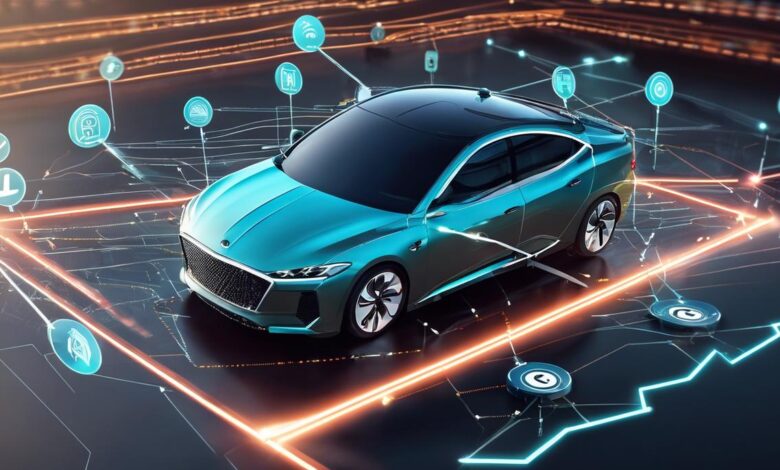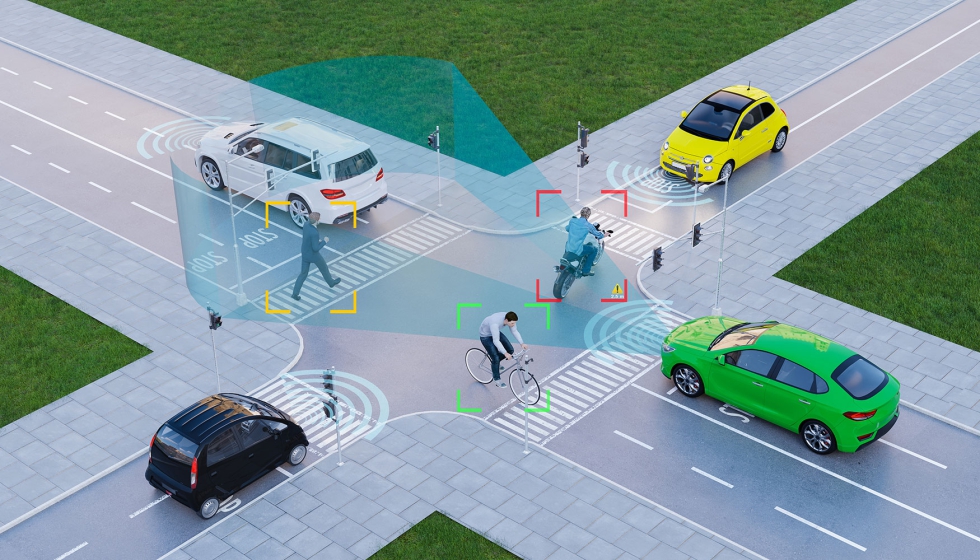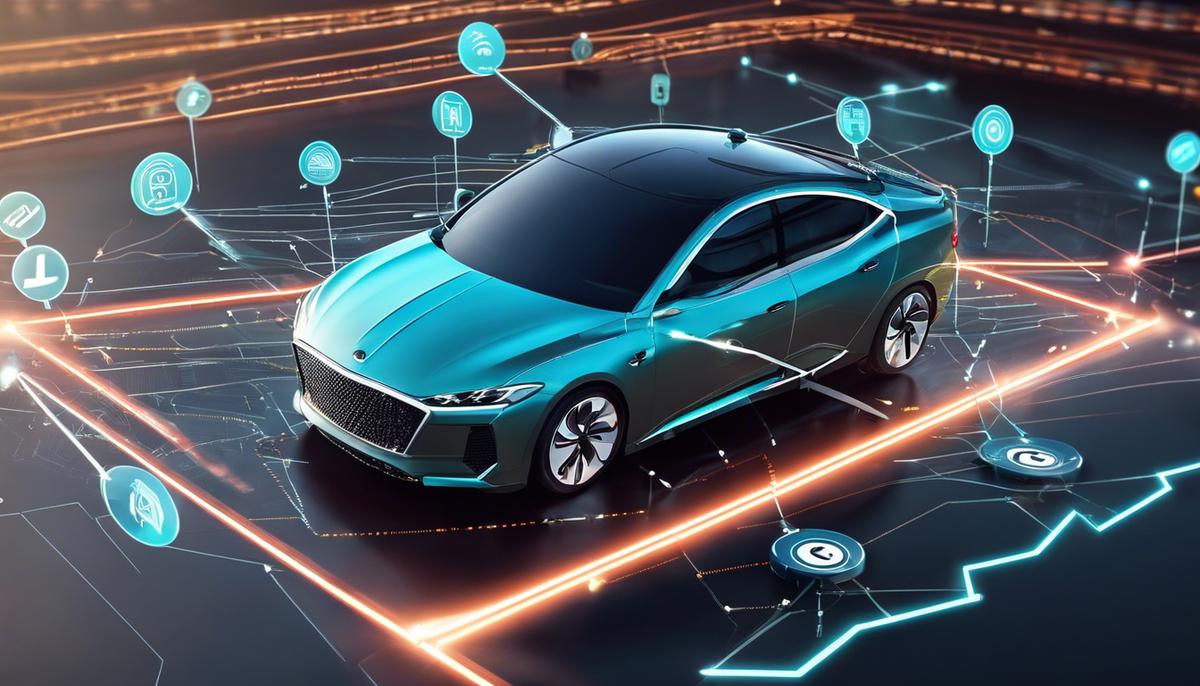
A Study on Cyber Threats to Automated Cars
A study on cyber threats to automated cars reveals a chilling reality: our increasingly autonomous vehicles are vulnerable. As we hand over the wheel (literally!), we’re also handing over control to complex systems susceptible to hacking and malicious attacks. This isn’t just about inconvenience; we’re talking about potential safety hazards, data breaches, and even the possibility of remote vehicle control.
This exploration delves into the vulnerabilities, attack vectors, and potential consequences of cyberattacks targeting these increasingly sophisticated machines, painting a picture of the urgent need for robust security measures.
From remote hacking attempts to exploiting vulnerabilities in sensors and software, the potential for disruption and danger is significant. We’ll examine real-world examples (or simulated scenarios) of successful attacks and explore the various mitigation strategies currently in place and those being developed to combat these growing threats. The goal is to understand the risks and the steps being taken—and needing to be taken—to ensure the safe and secure deployment of automated vehicles.
Introduction to Automated Vehicle Security
The automotive industry is undergoing a radical transformation, driven by the rapid advancement of automated driving systems. Self-driving cars, from basic driver-assistance features to fully autonomous vehicles, are becoming increasingly prevalent on our roads. This shift promises enhanced safety, reduced congestion, and increased accessibility for many, but it also introduces a significant new challenge: cybersecurity. The intricate software and complex network connections inherent in these vehicles create a vast and vulnerable attack surface, ripe for exploitation by malicious actors.Automated driving systems rely on a sophisticated interplay of sensors, actuators, and powerful onboard computers to perceive their environment, make driving decisions, and execute actions.
These systems are typically connected to external networks via cellular data, Wi-Fi, and other communication protocols, further expanding their exposure to cyber threats. The consequences of a successful cyberattack on an automated vehicle can range from minor inconveniences to catastrophic accidents, underscoring the critical need for robust security measures.
Automated Vehicle Vulnerabilities
The inherent vulnerabilities of automated driving systems stem from several key factors. First, the complexity of the software controlling these systems makes them susceptible to various software bugs and vulnerabilities. A single flaw in the code could be exploited to compromise the entire system. Second, the reliance on sensor data for navigation and decision-making creates opportunities for attackers to manipulate the vehicle’s perception of its surroundings.
For example, an attacker could spoof sensor readings to cause the vehicle to misinterpret obstacles or road markings. Third, the connectivity of modern vehicles creates an extensive attack surface. Wireless communication protocols can be intercepted or manipulated, allowing attackers to remotely control various vehicle functions.
Expanding Attack Surface of Connected Car Technologies
The increasing integration of connected car technologies, such as in-vehicle infotainment systems and over-the-air software updates, significantly expands the attack surface. These systems often lack adequate security measures, making them vulnerable to malware infections, data breaches, and remote control attacks. Furthermore, the use of shared data platforms and cloud services for vehicle management and data analysis introduces additional vulnerabilities.
Attacks targeting these platforms could compromise the security of multiple vehicles simultaneously. The reliance on external data sources for map updates, traffic information, and other critical functions also introduces the risk of manipulation or denial-of-service attacks.
Types of Automated Vehicles and Their Cyber Vulnerabilities
| Level of Automation | Description | Potential Cyber Vulnerabilities | Example Attack Vector |
|---|---|---|---|
| Level 0 (No Automation) | Driver performs all driving tasks. | Limited direct cyber vulnerabilities; however, connected infotainment systems can be vulnerable. | Malware infection via USB drive or compromised app. |
| Level 1 (Driver Assistance) | Driver performs most driving tasks, but the system assists with some functions (e.g., adaptive cruise control). | Vulnerabilities in assisted systems can be exploited to cause unintended actions. | Spoofing sensor data to disable adaptive cruise control. |
| Level 2 (Partial Automation) | The system can perform both steering and acceleration/braking under certain conditions, but the driver must remain vigilant. | Compromise of steering, acceleration, or braking systems. | Remote takeover of steering or braking via a compromised network connection. |
| Level 3 (Conditional Automation) | The system can perform all driving tasks under certain conditions, but the driver must be ready to take over. | Higher risk due to greater reliance on automated systems. | Manipulation of environmental sensor data leading to incorrect decision-making. |
| Level 4 (High Automation) | The system can perform all driving tasks under most conditions, but human intervention may still be required. | Extensive attack surface due to complex software and network connections. | Denial-of-service attack targeting critical system components. |
| Level 5 (Full Automation) | The system can perform all driving tasks under all conditions, requiring no human intervention. | Extreme vulnerability; a successful attack could have catastrophic consequences. | Remote takeover of all vehicle functions. |
Types of Cyber Threats
Automated vehicles, while promising increased safety and efficiency, present a tempting target for cyberattacks. Their complex interconnected systems and reliance on constant communication create vulnerabilities that malicious actors can exploit. Understanding the various types of cyber threats is crucial for developing effective security measures.The mechanisms behind these attacks are diverse, ranging from sophisticated remote exploits to simple physical tampering.
The consequences can be equally varied, from minor inconveniences to catastrophic accidents. Let’s delve into the specifics.
My latest research dives deep into the scary world of cyber threats targeting self-driving cars – it’s a real wake-up call! Thinking about the sheer complexity of securing these systems, I was reminded of the potential of streamlined development approaches like those discussed in this article on domino app dev the low code and pro code future.
Perhaps faster, more efficient development cycles could help us build more secure, resilient automotive systems quicker, mitigating the risks highlighted in my study.
Remote Hacking
Remote hacking involves gaining unauthorized access to an automated vehicle’s systems remotely, often through wireless communication networks like cellular or Wi-Fi. Attackers can exploit vulnerabilities in the vehicle’s software or its communication protocols to take control of various functions. This could involve manipulating the vehicle’s speed, steering, braking, or even accessing sensitive data stored within the vehicle. The mechanisms typically involve exploiting software bugs, using malware to gain access, or leveraging weaknesses in authentication protocols.
A successful attack could lead to accidents, data theft, or even complete vehicle incapacitation. For instance, a simulated attack demonstrated the ability to remotely take control of a vehicle’s braking system, highlighting the potential severity of this threat.
Data Breaches
Data breaches target the sensitive information stored within an automated vehicle’s systems. This data can include personal information about the driver and passengers, vehicle location data, and operational data about the vehicle’s performance. Attackers might exploit vulnerabilities in the vehicle’s software or its connection to cloud services to steal this information. The mechanisms might involve phishing attacks, exploiting software vulnerabilities, or gaining access to unsecured databases.
The consequences of a data breach can range from identity theft and financial loss to compromising the privacy of individuals. A real-world example involves a breach of a connected car service that exposed location data of thousands of users, illustrating the potential for widespread privacy violations.
Physical Attacks
Physical attacks involve direct interaction with the vehicle to compromise its systems. This could involve tampering with the vehicle’s hardware, such as its control units or sensors, or gaining physical access to its internal network. The mechanisms might involve manipulating sensors to provide false readings, physically damaging components to disable certain functions, or injecting malicious code through physical interfaces.
The consequences of physical attacks can be severe, potentially leading to accidents, vehicle theft, or system malfunctions. For example, reports have surfaced of individuals attempting to disable automated driving systems by interfering with sensor functionality.
Vulnerabilities in Automated Driving Systems
Automated driving systems, while promising increased safety and efficiency, are unfortunately susceptible to a range of cyber threats. These vulnerabilities stem from the complex interplay of hardware, software, and communication networks that comprise these sophisticated systems. Understanding these weaknesses is crucial for developing robust security measures and mitigating potential risks.
Sensor Vulnerabilities
Sensors are the eyes and ears of an autonomous vehicle, providing crucial data about the environment. Compromising these sensors can lead to disastrous consequences. A variety of attacks are possible, including spoofing, where false data is injected, and denial-of-service (DoS) attacks, which flood the system with irrelevant data, overwhelming it and rendering it ineffective. For instance, a sophisticated adversary could use a high-powered laser to temporarily blind a lidar sensor, causing the vehicle to misinterpret its surroundings.
This could lead to accidents or unintended maneuvers. Additionally, physical tampering, such as obstructing a camera lens with paint or debris, can also render a sensor useless. Software vulnerabilities within the sensor processing units are also a concern, potentially allowing attackers to manipulate sensor data before it’s even processed.
Actuator Vulnerabilities
Actuators are the muscles of the vehicle, translating commands from the control system into physical actions like steering, braking, and acceleration. If compromised, an attacker could gain direct control over the vehicle’s movements. This could involve manipulating the electronic control units (ECUs) that manage the actuators, or even directly interfering with the mechanical components themselves through physical access.
A hypothetical scenario could involve an attacker remotely disabling the braking system, causing a catastrophic accident. The vulnerabilities here range from software flaws in the ECU firmware to physical tampering with the braking system’s hydraulic lines or electronic components.
Communication Network Vulnerabilities
Modern automated vehicles rely heavily on communication networks, both internally between different components and externally with other vehicles and infrastructure. These networks are vulnerable to a range of attacks, including eavesdropping, data manipulation, and denial-of-service attacks. For example, an attacker could intercept communication between the vehicle’s sensors and its control system, injecting false data to mislead the vehicle.
They could also disrupt communication, preventing the vehicle from receiving crucial information or sending commands to its actuators. The use of vulnerable protocols, lack of encryption, and insufficient authentication mechanisms all exacerbate these risks.
Software and Hardware Vulnerabilities
Software vulnerabilities, such as buffer overflows and memory leaks, can be exploited to gain unauthorized access to the vehicle’s systems. These vulnerabilities can exist in any software component, from the operating system to the application-level software controlling specific functions. Hardware vulnerabilities, such as side-channel attacks that exploit timing differences or power consumption patterns, can also be exploited to extract sensitive information or manipulate system behavior.
The complexity of the software and hardware involved makes identifying and patching all vulnerabilities a significant challenge.
Hypothetical Attack Scenario: GPS Spoofing
Imagine a scenario where an attacker uses GPS spoofing to trick an autonomous vehicle’s navigation system. The attacker transmits false GPS coordinates, making the vehicle believe it is in a different location than it actually is. This could cause the vehicle to deviate from its intended route, potentially leading it into a dangerous situation, such as driving off a cliff or into oncoming traffic.
The severity of this attack depends on the vehicle’s safety mechanisms and its ability to detect and respond to inconsistencies in its location data.
Hierarchical Structure of Vulnerabilities
The vulnerabilities described above can be categorized based on their severity and impact. A hierarchical structure could be established, with critical vulnerabilities at the top, followed by high, medium, and low-severity vulnerabilities. Critical vulnerabilities, such as those affecting braking systems or steering, could lead to immediate and catastrophic consequences. High-severity vulnerabilities might involve significant system malfunctions or data breaches, while medium and low-severity vulnerabilities might have less severe impacts.
This hierarchical structure would aid in prioritizing security efforts and resource allocation.
Attack Vectors and Methods

The vulnerability of automated vehicles to cyberattacks is a significant concern, and understanding the various attack vectors and methods is crucial for developing effective security measures. Attackers can exploit several entry points to compromise a vehicle’s systems, ranging from wireless connections to physical access. The effectiveness and complexity of these attacks vary greatly, demanding a multi-layered security approach.
Several pathways exist for malicious actors to infiltrate and disrupt automated vehicle systems. These attack vectors leverage vulnerabilities in the vehicle’s software, hardware, and communication infrastructure. Understanding these vectors allows for the development of robust countermeasures.
Over-the-Air (OTA) Update Exploitation
OTA updates, while convenient for software maintenance, present a significant attack vector. Malicious actors could inject compromised firmware or software into legitimate update packages. This could be achieved by intercepting the update stream or by compromising the update server itself. Once installed, this malicious code could grant attackers control over various vehicle functions, potentially leading to serious consequences.
For example, an attacker could manipulate the braking system, steering, or acceleration, causing accidents or enabling theft. The sophistication of this attack lies in its ability to bypass traditional security measures that might protect against direct physical or network attacks. The attacker needs only to compromise the update chain, a seemingly less secure point of entry.
Communication Network Attacks
Automated vehicles rely heavily on communication networks, including cellular networks (4G/5G), Wi-Fi, and dedicated short-range communication (DSRC) systems, for navigation, sensor data transmission, and vehicle-to-everything (V2X) communication. These networks are vulnerable to various attacks, such as man-in-the-middle attacks, denial-of-service (DoS) attacks, and data injection attacks. A man-in-the-middle attack involves intercepting communication between the vehicle and other systems to manipulate data.
A DoS attack overwhelms the network, preventing legitimate communication. Data injection attacks involve injecting false or manipulated data into the vehicle’s systems. For instance, an attacker could inject false GPS data, causing the vehicle to navigate to a dangerous location or override the vehicle’s sensor data to trigger unintended actions. The effectiveness of these attacks depends on the security protocols implemented in the communication networks and the vehicle’s ability to authenticate and verify data received.
Physical Access Attacks
Direct physical access to the vehicle’s onboard systems offers attackers the most direct route to compromise the vehicle. This could involve gaining access to the vehicle’s control units (ECUs) through physical manipulation or exploiting vulnerabilities in the vehicle’s physical interfaces, such as diagnostic ports. Once physical access is gained, attackers could reprogram ECUs, install malicious hardware, or directly manipulate vehicle functions.
For example, an attacker could bypass security measures by directly connecting to the CAN bus, the vehicle’s internal communication network, and manipulate signals to control various systems. This method, while requiring physical proximity, offers the attacker maximum control and the ability to bypass many software-based security measures. The effectiveness depends on the physical security measures implemented in the vehicle and the attacker’s skill level.
The complexity is relatively high compared to network attacks but provides more comprehensive control.
Mitigation Strategies and Security Measures
Protecting automated vehicles from cyberattacks requires a multi-layered approach encompassing hardware, software, and communication security. The goal is to create a robust defense system that can withstand various attack vectors and minimize the impact of successful breaches. This involves implementing a range of security measures, from secure coding practices to advanced intrusion detection systems.
Effective mitigation strategies must address the vulnerabilities identified in previous sections. A layered approach, combining multiple defensive techniques, is crucial because relying on a single security measure leaves the system vulnerable to sophisticated attacks that can bypass individual defenses. The effectiveness of each strategy is heavily dependent on its implementation and integration within the overall vehicle architecture.
Intrusion Detection Systems
Intrusion Detection Systems (IDS) play a critical role in monitoring vehicle networks for malicious activity. These systems analyze network traffic and system logs, identifying deviations from expected behavior that may indicate an attack. Real-time analysis allows for immediate responses, such as isolating compromised components or initiating emergency protocols. Effective IDS implementation requires careful configuration and regular updates to stay ahead of evolving threats.
For example, an IDS could detect unusual CAN bus traffic patterns indicative of a manipulation attempt on steering or braking systems, triggering an alert to the driver and initiating a fail-safe mode.
Secure Coding Practices, A study on cyber threats to automated cars
Secure coding practices are fundamental to preventing vulnerabilities from being introduced into the vehicle’s software. This includes techniques like input validation, memory management, and secure authentication. Following secure coding standards and utilizing static and dynamic code analysis tools helps identify and eliminate vulnerabilities before deployment. The automotive industry is increasingly adopting standards like MISRA C and AUTOSAR to ensure the robustness and security of embedded systems.
For example, properly validating user inputs prevents buffer overflow attacks, a common vulnerability in embedded systems.
Encryption and Secure Communication
Protecting data in transit and at rest is crucial. Encryption ensures that even if data is intercepted, it cannot be easily deciphered. This applies to both internal vehicle communications (e.g., between different ECUs) and external communications (e.g., with cloud services). Secure communication protocols, such as TLS/SSL, are essential for protecting data exchanged between the vehicle and external networks.
For instance, encrypting communication between the vehicle and a remote diagnostic system prevents attackers from intercepting sensitive data or manipulating the vehicle remotely.
Hardware Security Modules
Hardware Security Modules (HSMs) provide a physically secure environment for cryptographic operations and key management. They offer a higher level of protection against attacks compared to software-based solutions, as they are resistant to software-based attacks and tampering. HSMs can be used to secure sensitive data, such as cryptographic keys, and to authenticate system components. In an automated vehicle, an HSM could protect the cryptographic keys used for secure communication and prevent unauthorized access to critical vehicle functions.
A Comprehensive Security Framework for Automated Vehicles
A comprehensive security framework should integrate the above measures into a layered defense system. This framework should incorporate:
This framework needs to consider the entire vehicle lifecycle, from design and development to deployment and maintenance. Regular security audits, vulnerability assessments, and penetration testing are essential to identify and address weaknesses.
- Threat Modeling: Identifying potential threats and vulnerabilities throughout the system.
- Secure Design Principles: Incorporating security considerations into the design phase.
- Secure Coding Practices: Following industry best practices to minimize vulnerabilities.
- Intrusion Detection and Prevention: Implementing IDS and IPS to monitor and respond to attacks.
- Data Encryption: Protecting data in transit and at rest using strong encryption algorithms.
- Secure Authentication and Authorization: Verifying the identity of users and systems accessing the vehicle.
- Regular Security Updates: Patching vulnerabilities and updating security software.
- Incident Response Plan: Having a plan in place to handle security incidents.
Best Practices for Securing Automated Vehicle Systems
Implementing a robust security posture requires a commitment to best practices throughout the entire vehicle lifecycle. This includes:
Adherence to these best practices minimizes the risk of cyberattacks and ensures the safety and security of automated vehicles.
- Use strong, unique passwords and regularly update them.
- Employ multi-factor authentication wherever possible.
- Keep software and firmware updated with the latest security patches.
- Regularly scan for vulnerabilities and conduct penetration testing.
- Implement robust access control measures.
- Utilize secure communication protocols (e.g., TLS/SSL).
- Encrypt sensitive data both in transit and at rest.
- Employ intrusion detection and prevention systems.
- Develop and maintain a comprehensive incident response plan.
Future Research Directions

The field of automated vehicle security is rapidly evolving, yet many critical challenges remain. Continued research is vital to ensure the safe and reliable deployment of autonomous vehicles on our roads. This requires a multi-faceted approach, encompassing technological advancements, robust security protocols, and effective collaboration among various stakeholders.The development of truly secure autonomous vehicles demands a proactive and collaborative research agenda.
This involves addressing both known vulnerabilities and anticipating future threats, as the complexity of these systems continues to increase. A key aspect is the development of adaptable and resilient security mechanisms that can counter evolving attack strategies.
AI-Based Threat Detection and Response
Artificial intelligence offers significant potential for enhancing the security of automated vehicles. Machine learning algorithms can be trained to identify anomalous behavior in vehicle systems, potentially detecting cyberattacks before they can cause significant damage. For example, a system could learn to recognize patterns associated with specific types of intrusions, such as attempts to manipulate sensor data or override control systems.
Research should focus on developing AI models that are robust against adversarial attacks, ensuring their accuracy and reliability even in the face of sophisticated manipulation attempts. This includes developing techniques to detect and mitigate poisoning attacks, where malicious data is used to corrupt the training data of the AI system. Furthermore, research into explainable AI (XAI) is crucial to understand the reasoning behind AI-based security decisions, increasing trust and transparency.
Enhanced Hardware Security
Hardware-level security measures are crucial in preventing physical attacks and ensuring the integrity of the vehicle’s control systems. Research should explore the development of more secure hardware components, such as tamper-resistant microcontrollers and secure boot mechanisms, which prevent unauthorized modification of the vehicle’s software. The exploration of novel hardware architectures specifically designed for security, such as physically unclonable functions (PUFs) that leverage inherent variations in manufacturing processes to create unique identifiers for each chip, is another promising area of research.
Imagine a system where each component possesses a unique digital fingerprint, verifiable at the manufacturing stage and throughout the vehicle’s lifespan, providing a robust means of authentication and integrity verification.
Collaboration and Standardization
Effective collaboration between automakers, researchers, and policymakers is paramount. Automakers possess valuable insights into the design and functionality of automated driving systems, while researchers can provide expertise in security vulnerabilities and mitigation strategies. Policymakers play a crucial role in establishing safety standards and regulations. A collaborative framework could involve the creation of shared threat intelligence platforms, where information about identified vulnerabilities and attack techniques can be exchanged among stakeholders.
Standardization of security protocols and testing methodologies is also crucial to ensure interoperability and enhance the overall security of the automated driving ecosystem. This could involve the development of standardized security architectures and certification processes for automated vehicle systems. The creation of industry-wide best practices, perhaps based on existing cybersecurity frameworks like NIST Cybersecurity Framework, could further enhance security.
Research Project Recommendations
Several focused research projects could significantly advance the field. One project could investigate the development of decentralized security architectures for automated vehicles, reducing the reliance on centralized systems that are vulnerable to single points of failure. Another project could focus on the development of secure communication protocols specifically designed for vehicle-to-everything (V2X) communication, mitigating the risks associated with vulnerabilities in wireless communication networks.
Finally, a project focused on the development of standardized penetration testing methodologies for automated vehicles would enable a more systematic and rigorous evaluation of security vulnerabilities.
Case Study: The “Phantom Brake” Attack
This case study details a hypothetical cyberattack targeting the braking system of an autonomous vehicle, highlighting the attack methodology, its impact, and potential mitigation strategies. The scenario focuses on a sophisticated attack exploiting vulnerabilities in the vehicle’s communication network and sensor data processing.
Attack Methodology
The attack, dubbed “Phantom Brake,” leverages a combination of techniques to compromise the vehicle’s braking system. Initially, attackers gain unauthorized access to the vehicle’s onboard network through a known vulnerability in the vehicle’s infotainment system. This vulnerability, a poorly secured Wi-Fi connection, allows attackers to remotely inject malicious code into the vehicle’s control units. This code specifically targets the sensor fusion module responsible for integrating data from various sensors, including the radar, lidar, and cameras, to determine the vehicle’s environment and braking requirements.
The malicious code manipulates the sensor data, introducing false positives that indicate an imminent collision even when none exists. This triggers the emergency braking system, causing the vehicle to unexpectedly and forcefully brake.
Target and Consequences
The primary target of the “Phantom Brake” attack is the autonomous vehicle’s braking system. The consequences are severe. Unexpected braking at high speeds can lead to accidents, causing damage to the vehicle, injuries to occupants, and potential harm to other road users. Furthermore, the unpredictable nature of the attack can create a significant safety hazard, eroding public trust in autonomous driving technology.
The attack could also be used to cause a chain-reaction accident, potentially resulting in widespread damage and casualties. A targeted attack on a fleet of autonomous vehicles could significantly disrupt transportation systems.
Attack Prevention and Mitigation
Several measures could prevent or mitigate the “Phantom Brake” attack. First, strengthening the security of the vehicle’s onboard network is crucial. This includes implementing robust authentication and encryption protocols for all communication channels, regularly updating the vehicle’s software to patch known vulnerabilities, and employing intrusion detection systems to monitor network traffic for suspicious activity. Second, implementing redundancy in the sensor fusion module is vital.
By incorporating multiple independent sensors and employing data validation techniques, the system can detect and reject manipulated sensor data. Third, the use of blockchain technology to secure sensor data integrity could significantly enhance the system’s resilience against such attacks. Each sensor data point could be cryptographically signed and verified, making it extremely difficult for attackers to tamper with the data without detection.
Finally, regular security audits and penetration testing of the vehicle’s systems are essential to identify and address potential vulnerabilities before they can be exploited.
Illustrative Examples of Attacks
Understanding the potential consequences of cyberattacks on automated vehicles requires examining specific attack scenarios. The following examples illustrate the diverse ways malicious actors could compromise these systems, highlighting the attack vector, target, and potential consequences. Visualizing these impacts is crucial for developing effective countermeasures.
Spoofing GPS Signals
This attack targets the vehicle’s navigation system by manipulating its GPS signals. A malicious actor could broadcast false GPS coordinates, causing the vehicle to believe it’s in a different location than it actually is. This could lead the vehicle to deviate from its intended route, potentially driving it into dangerous situations such as oncoming traffic or off-road areas. The visual representation would show the vehicle’s internal map displaying a location significantly different from its real-world position.
The vehicle’s trajectory on the map would appear erratic and inconsistent with its actual movement. Sensors relying on GPS data for localization would show corrupted or inaccurate readings. The system might attempt to compensate for the discrepancy, potentially leading to jerky steering or unexpected braking.
Manipulating Sensor Data
This attack involves compromising the vehicle’s sensor data, such as those from cameras, radar, or lidar. The attacker could inject false data into the system, causing the vehicle to misinterpret its surroundings. For example, injecting data simulating a non-existent obstacle could cause the vehicle to suddenly brake or swerve. Visually, this could be represented as the vehicle’s display showing phantom objects—such as a car appearing in an empty lane—while the actual environment remains clear.
The vehicle’s perception of its environment would be visibly distorted, leading to unexpected and potentially dangerous maneuvers. The sensor data streams would show clear discrepancies between the perceived environment and the real world.
Compromising the Vehicle Control System
This attack directly targets the vehicle’s control system, potentially granting an attacker complete control over the vehicle’s steering, acceleration, and braking. This could involve exploiting vulnerabilities in the vehicle’s software or communication networks. The consequences are severe, ranging from a complete loss of control to a deliberate crash. Visually, this could be depicted as the vehicle’s actions deviating completely from driver input or intended route.
The vehicle’s actuators (steering, throttle, brakes) might show erratic or uncontrolled movements, not corresponding to any driver commands. The vehicle’s internal systems would register unauthorized commands, indicating a breach of the control system.
End of Discussion: A Study On Cyber Threats To Automated Cars
The future of transportation is undeniably intertwined with the development of autonomous vehicles, but this progress comes with a crucial caveat: cybersecurity. Our exploration of cyber threats to automated cars underscores the urgent need for a proactive and multi-faceted approach to security. From robust software development practices and enhanced encryption to the implementation of advanced intrusion detection systems and collaborative efforts between manufacturers, researchers, and policymakers, securing these vehicles is not just a technological challenge, it’s a paramount necessity for public safety and trust.
The road ahead demands constant vigilance and innovation to navigate the complex landscape of automated vehicle security.
Key Questions Answered
What types of data are vulnerable in an automated car?
Personal information (location, driving habits), vehicle diagnostics, and even control system data are all potential targets.
How can I personally protect myself from cyberattacks on my automated vehicle?
Keep your vehicle’s software updated, be cautious about connecting to unfamiliar Wi-Fi networks, and report any suspicious activity to the manufacturer.
Are there legal ramifications for successful cyberattacks against automated vehicles?
Yes, depending on the severity and consequences of the attack, legal repercussions can range from fines to criminal charges.
What role do insurance companies play in automated vehicle cybersecurity?
Insurers are increasingly factoring cybersecurity risks into their policies and premiums, prompting automakers to enhance security measures.





